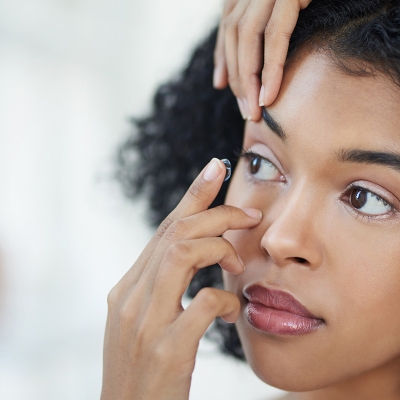7 ways to treat double vision
People may experience this eye condition for different reasons — and some are more serious than others. Find out what it is, and how it can be treated.

For people who experience double vision (diplopia), it can be scary and disorienting. It can be caused by several vision or health factors, some more serious than others.
It’s important to know that double vision is quite common. According to the Cleveland Clinic, more than 800,000 people a year in the U.S. see an eye care provider about it.1
Whether a person’s double vision is temporary or ongoing, it’s important for them to see an eye care provider right away. They’ll be able to figure out what’s causing it and help get them on the road to recovery.
Learn what causes double vision, how it can affect a person’s eyes, and what eye care providers can do about it.
Eye care providers in the UnitedHealthcare Vision Network can help diagnose double vision and get you the right treatment. Search for a provider now.
What is double vision, and what can cause it?
Double vision happens when a person believes they’re seeing 2 images instead of 1 — even if they’re only looking at 1 object. Double vision can be short-term or a sign of a more serious problem.
There are 2 main types of double vision:1
1. Monocular. This type occurs in 1 eye and continues even when the other eye is closed.
It can be caused by things like:2,3
- A refractive error, like astigmatism (that’s when a person has trouble seeing objects both close and at a distance)
- A change in the shape of an eye, which can cause distorted vision
- Dislocated lens (when the eye’s lens moves out of place or wiggles)
- Dry eye
- Early stages of cataracts (clouding of the lens)
2. Binocular. This type happens when both eyes are open and goes away when one eye is closed.
It can be caused by a mix of common and serious conditions such as:2,3
- Eye misalignment (strabismus). That’s when the muscles around the eye are not developed or weak. It can cause the eyes to not be aligned right and point in the same direction. When a person has crossed eyes, that’s the most common form of strabismus.
- Brain disorders. These can include multiple sclerosis (a condition that disrupts information between the brain and body), stroke (a condition where blood flow is disrupted to the brain) and myasthenia gravis. That’s an illness where the muscles in a person’s body, including those in their eyes, tire easily and become weak.
- Diabetes. It can cause issues with the nerves that control the muscles in the eyes.
Double vision may also be categorized as either vertical or horizontal by an eye care provider. That can depend on how it’s showing up in a person’s field of vision.1
If double vision happens suddenly, it can be a cause for concern. A person will want to seek emergency medical advice right away.
Even if it’s brief, it’s a good idea to talk to an eye care provider. They can help a person figure out why it’s happening and help treat it.
What are some ways of telling if someone has double vision?
The only real symptom of double vision is seeing double. So it’s common for an adult to tell someone, like an eye care provider, what’s happening to them.4
But it might be scarier or more difficult for a child to tell their parent about it. Parents will want to watch out for these specific signs of double vision in their children:5
- Covering one eye with their hands
- Flicking the eyes side to side
- Looking at something with an unusual head position
- Squinting to see better
If a parent sees their child doing any of these things, it’s a good idea to schedule an appointment with their eye care provider right away.
7 ways to treat double vision
If a person is experiencing double vision, here are some possible ways an eye care provider can treat it:1,3,6,7,8
1. Corrective lenses
- Single vision glasses. They ensure that a person has the full correction for astigmatism in their lenses, which may help with potential double vision. (For information on digital single vision lenses, a special type of single vision lenses, download this helpful guide.)
- Prism glasses. These are special lenses with prisms that can help align the images seen by each eye. It can help reduce or even get rid of double vision. These glasses are particularly useful for people with eye muscle issues.3,6,7
- Bifocal or multifocal lenses. These lenses can help with double vision caused by focusing issues. They can be especially helpful for people with presbyopia. That’s a common, age-related condition where people have trouble focusing on nearby objects.8
2. Eye exercises and vision therapy
- Vision therapy.7 That’s a series of eye exercises and activities that can improve eye coordination and focus. Eye care providers often recommend it for children and adults with binocular vision problems.
- Patching. This involves covering 1 eye with a patch or a filter. It can help the brain ignore images from the affected eye, reducing double vision. It’s particularly good for temporary relief.6,7
3. Medications
- Botox (botulinum toxin) injections. Getting a shot of Botox in the eye muscles can temporarily weaken them. That helps them align the eyes and reduce double vision. It’s often used for conditions like crossed eyes.6
- Oral medications. Certain medications can help with underlying conditions that cause double vision. These can include thyroid disorders or myasthenia gravis (see above).7
4. Surgery
- Strabismus surgery. This involves adjusting the eye muscles to align the eyes properly. It’s a common treatment for double vision caused by misaligned eyes in children.3
- Cataract surgery. If double vision is caused by cataracts, removing the cataracts and replacing the lens can help improve a person’s vision.3
5. Lifestyle changes
- Reducing screen time. Spending too much time in front of digital screens, like computers and smartphones, can make double vision worse.1
- Improving lighting. Proper lighting can reduce glare and make it easier to see and reduce the strain on the eyes.
6. Addressing health conditions
- Getting treatment for brain disorders. Serious health conditions like multiple sclerosis, stroke or brain tumors can cause double vision. Seeing a doctor or eye care provider can be an important step to getting double vision under control.6
- Managing diabetes. High blood sugar levels can affect the nerves and blood vessels in the eyes, leading to double vision. Properly managing diabetes can help prevent or reduce it.3
7. Regular eye exams
Another great way to treat double vision is through regular eye exams. They’re essential for monitoring a person’s vision. But they can also help keep an eye on a person’s double vision, whether it’s getting better, and how well the treatment is working.1
Eye care providers can also help detect and manage underlying conditions, like diabetes, that may be causing the issue in the first place. They can even refer a person to an eye specialist or doctor who can help further.
Stay on top of your eye health with a UnitedHealthcare Vision Network provider. Search now.
Sources:
- Diplopia (double vision) Cleveland Clinic, last reviewed August 2024.
- Diagnosing double vision NYU Langone Health
- Double vision (diplopia) Harvard Medical School Harvard Health Publishing, September 2023.
- Symptoms of double vision Stanford Medicine
- Double vision Columbia University Irving Medical Center
- Treatment options for double vision Stanford Medicine
- Nonsurgical treatment for double vision NYU Langone Health
- Presbyopia American Academy of Ophthalmology EyeWiki, last reviewed March 2024.


